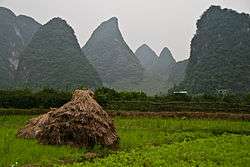Stook
A stook, also referred to as a shock,[1] is a circular or rounded arrangement of swathes of cut grain stalks placed on the ground in a field. Typically sheaves of grains such as wheat, barley and oats may be 'stooked' so they are ready for threshing.
In England a stook may also particularly refer to twelve sheaves.
The purpose of these practices is to protect unthreshed grain, hay or straw from moisture until it can be picked up and brought into long-term storage. The unthreshed grain also cures while in a stook.
The word stook may also have a general meaning of 'bundle' or 'heap' applicable to items other than sheaves or bales. For example, in the era when haystacks were common, they were also called stooks, shocks, or ricks, although today baling and haylage (either chopped and ensilaged in silos or as bales ensileaged inside polymer wrappers) have largely replaced the haystack method of storing hay. But even in the baling era, in North America, a stook also refers to a stack of six, ten or fifteen bales of hay or straw (the small square bales, 70–90 lb (30–40 kg) each, that can picked up by a person), stacked in the field. The bales are stacked and deposited by a "stooking machine" or "stooker" that is dragged, sled-like, behind the baler. The stooking sled has four, five, or six fingers that hold the bales until the stook is complete. When the stook is complete the "stacker" steps on a lever to release the stook. The fingers drop to the ground and the finished stook slides off the fingers. The sled resets itself and is ready to be filled again. The bales are stacked on the diagonal to shed the rain and to minimize acquiring moisture from the ground before being picked up.
An automatic bale stooker was eventually designed to eliminate the need for a person to manually stack and trip the stook-release. The automatic stooker is positioned behind the baler and collects released bales and sends them up an inclined shute. The bale falls through a series of bars into the "3-2-1" configuration. Once all six bales are in position the platform trips, drops the stook in the field, and automatically returns to the loading position.[2] Allied produced a model of stooked in the 1980s that can still be found across the countryside in Canada today.
Shocking
Before mechanical harvesting became the norm, a common agricultural practice was to manually cut sheaves of grain, tie them in bundles, and stack them against one another vertically to form a "shock" so that they could air dry.[3]
